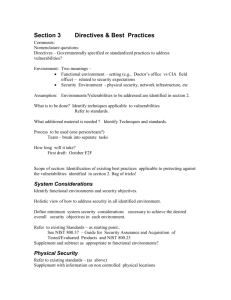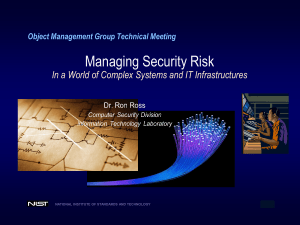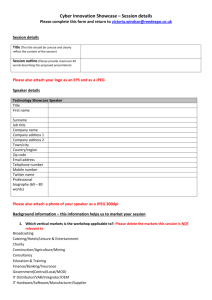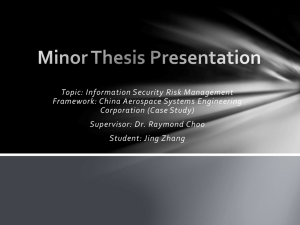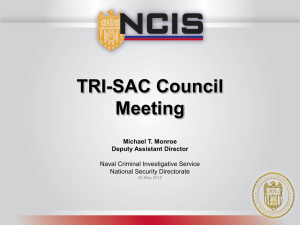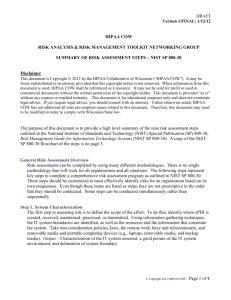Dr. Ron Ross, Fellow, National Institute of Standards and Technology
advertisement
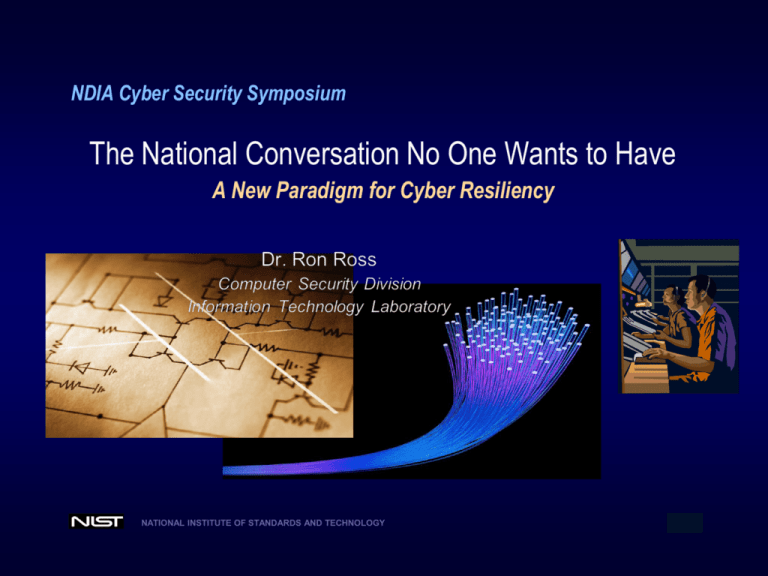
NDIA Cyber Security Symposium The National Conversation No One Wants to Have A New Paradigm for Cyber Resiliency NATIONAL INSTITUTE OF STANDARDS AND TECHNOLOGY 1 First, an easy risk management problem. NATIONAL INSTITUTE OF STANDARDS AND TECHNOLOGY 2 Risk. Function (threat, vulnerability, impact, likelihood) NATIONAL INSTITUTE OF STANDARDS AND TECHNOLOGY 3 The unlikely threat. Hi. I’m Sophie. Welcome to the NDIA Cyber Security Symposium! Our three-year old adopted pit bull. Cute. Lovable. Smart. NATIONAL INSTITUTE OF STANDARDS AND TECHNOLOGY 4 The vulnerability. NATIONAL INSTITUTE OF STANDARDS AND TECHNOLOGY 5 The impact. 100% and the likelihood?. NATIONAL INSTITUTE OF STANDARDS AND TECHNOLOGY 6 And now, a more difficult problem. NATIONAL INSTITUTE OF STANDARDS AND TECHNOLOGY 7 The computer… driven by firmware and software. Critical missions and business functions are at risk — affecting national and economic security interests of the United States… NATIONAL INSTITUTE OF STANDARDS AND TECHNOLOGY 8 We are vulnerable because our information technology is fragile and susceptible to a wide range of threats including: natural disasters. structural failures. cyber attacks. errors. NATIONAL INSTITUTE OF STANDARDS AND TECHNOLOGY 9 Advanced Persistent Threat An adversary that — Possesses significant levels of expertise / resources. Creates opportunities to achieve its objectives by using multiple attack vectors (e.g., cyber, physical, deception). Establishes footholds within IT infrastructure of targeted organizations: To exfiltrate information. To undermine / impede critical aspects of a mission, program, or organization. To position itself to carry out these objectives in the future. NATIONAL INSTITUTE OF STANDARDS AND TECHNOLOGY 10 Classes of Vulnerabilities A 2013 Defense Science Board Report described— Tier 1: Known vulnerabilities. Tier 2: Unknown vulnerabilities (zero-day exploits). Tier 3: Adversary-created vulnerabilities (APT). A significant number of vulnerabilities are “off the radar” of many organizations… NATIONAL INSTITUTE OF STANDARDS AND TECHNOLOGY 11 Good cyber hygiene is necessary… But not sufficient. Which Road to Follow? You can’t count, configure, or patch your way out of this problem space. Difficult decisions ahead. NATIONAL INSTITUTE OF STANDARDS AND TECHNOLOGY 12 The hard cybersecurity problems are buried below the water line… In the hardware, software, and firmware. NATIONAL INSTITUTE OF STANDARDS AND TECHNOLOGY 13 Complexity. An adversary’s most effective weapon in the 21st century. NATIONAL INSTITUTE OF STANDARDS AND TECHNOLOGY 14 When culture clashes with science… Science wins. NATIONAL INSTITUTE OF STANDARDS AND TECHNOLOGY 15 Weinberg's Second Law “If builders built buildings the way programmers wrote programs, then the first woodpecker that came along would destroy civilization.” -- The Psychology of Computer Programming (1971) NATIONAL INSTITUTE OF STANDARDS AND TECHNOLOGY . 16 Estimating Number of Vulnerabilities Alhazmi and others estimate that between 1% and 5% of flaws are security vulnerabilities. Source: Software Assessments, Benchmarks, and Best Practices, C. Jones. Source: Security Vulnerabilities in Software Systems - A Quantitative Perspective, O.H. Alhazmi. NATIONAL INSTITUTE OF STANDARDS AND TECHNOLOGY 17 Heartbleed and Shellshock should be a wake up call. NATIONAL INSTITUTE OF STANDARDS AND TECHNOLOGY 18 The argument for building stronger, more resilient information systems… Software assurance. Systems security engineering. Supply chain risk management. NATIONAL INSTITUTE OF STANDARDS AND TECHNOLOGY 19 For bridge builders, it's all about physics— Equilibrium, static and dynamic loads, vibrations, and resonance. NATIONAL INSTITUTE OF STANDARDS AND TECHNOLOGY 20 For information system developers, it's all about mathematics, computer science, architecture, and systems engineering— Trustworthiness, assurance, penetration resistance and resilience. NATIONAL INSTITUTE OF STANDARDS AND TECHNOLOGY 21 Getting the attention of the C-Suite. The elevator speech for cybersecurity requires a tall building. NATIONAL INSTITUTE OF STANDARDS AND TECHNOLOGY 22 TACIT Security Threat Assets Complexity MERRIAM-WEBSTER DICTIONARY tac.it adjective : expressed or understood without being directly stated Integration Trustworthiness NATIONAL INSTITUTE OF STANDARDS AND TECHNOLOGY 23 Threat Develop a better understanding of the modern threat space, including the capability of adversaries to launch sophisticated, targeted cyber-attacks that exploit specific organizational vulnerabilities. Obtain threat data from as many sources as possible. Include external and insider threat analysis. NATIONAL INSTITUTE OF STANDARDS AND TECHNOLOGY 24 Assets Conduct a comprehensive criticality analysis of organizational assets including information and information systems. Focus on mission/business impact. Use triage concept to segregate assets by criticality. NATIONAL INSTITUTE OF STANDARDS AND TECHNOLOGY 25 Complexity Reduce the complexity of the information technology infrastructure including IT component products and information systems. Employ enterprise architecture to consolidate, optimize, and standardize the IT infrastructure. Adopt cloud computing architectures to reduce the number of IT assets through on-demand provisioning of services. NATIONAL INSTITUTE OF STANDARDS AND TECHNOLOGY 26 Integration Integrate information security requirements and the security expertise of individuals into organizational development and management processes. Coordinate security requirements with mission/business owners; become key stakeholders. Embed security personnel into enterprise architecture, systems engineering, SDLC, and acquisition processes. NATIONAL INSTITUTE OF STANDARDS AND TECHNOLOGY 27 Trustworthiness Invest in more trustworthy and resilient information systems supporting organizational missions and business functions. Isolate critical assets into separate enclaves. Implement solutions using modular design, layered defenses, component isolation. NATIONAL INSTITUTE OF STANDARDS AND TECHNOLOGY 28 The road ahead. NATIONAL INSTITUTE OF STANDARDS AND TECHNOLOGY 29 Security should be a by-product of good design and development practices. NATIONAL INSTITUTE OF STANDARDS AND TECHNOLOGY 30 On the Horizon… NIST Special Publication 800-160 Systems Security Engineering An Integrated Approach to Building Trustworthy Resilient Systems NATIONAL INSTITUTE OF STANDARDS AND TECHNOLOGY 31 First Objective Provide a comprehensive statement of the systems security engineering discipline — its principles, concepts, and activities. NATIONAL INSTITUTE OF STANDARDS AND TECHNOLOGY 32 Second Objective Foster a common mindset to deliver security for any system, regardless of — its scope, size, complexity, or system life cycle stage. NATIONAL INSTITUTE OF STANDARDS AND TECHNOLOGY 33 Third Objective Demonstrate how systems security engineering processes — can be effectively integrated into systems engineering processes. NATIONAL INSTITUTE OF STANDARDS AND TECHNOLOGY 34 Building on International Standards Stakeholder requirements definition. Requirements analysis. Architectural design. Implementation. Integrating the RMF and security Integration. concepts, principles, and best practices into IEEE/ISO/IEC 15288 Verification. Transition. Systems and software engineering — System life cycle processes Validation. Operation. Maintenance. Disposal. NATIONAL INSTITUTE OF STANDARDS AND TECHNOLOGY 35 A Winning Strategy THREAT “Build It Right” Systems Engineering Software Assurance System Life Cycle Testing/Evaluation Trustworthiness Resiliency Design Architecture Acquisition Secure Coding Static Code Analysis Systems Integration Systems Security Engineering “Continuously Monitor” A two-pronged attack on the threat space Critical Missions and Business Functions Security Configurations Ongoing Authorization Separation of Duties Software Patching Traffic Analyses Security State Asset Inventory Network Sensors Incident Response Threat Assessment Situational Awareness Administrative Privileges Vulnerability Assessment Foundation of IT Components, Systems, Services NATIONAL INSTITUTE OF STANDARDS AND TECHNOLOGY 36 Some final thoughts. NATIONAL INSTITUTE OF STANDARDS AND TECHNOLOGY 37 Cybersecurity is the great challenge of the 21st century. Cybersecurity problems are hard— not easy. Are we prepared to do the heavy lifting? NATIONAL INSTITUTE OF STANDARDS AND TECHNOLOGY 38 Necessary and Sufficient Security Solutions… Cyber Security Hygiene COUNTING, CONFIGURING, AND PATCHING IT ASSETS Strengthening the IT Infrastructure SYSTEM/SECURITY ENGINEERING, ARCHITECTURE, AND RESILIENCY Has your organization achieved the appropriate balance? NATIONAL INSTITUTE OF STANDARDS AND TECHNOLOGY 39 Government Academia The essential partnership. Industry NATIONAL INSTITUTE OF STANDARDS AND TECHNOLOGY 40 Immediate Action Plan and Resources Conduct threat and vulnerability assessments. United States Computer Emergency Readiness Team https://www.us-cert.gov Conduct criticality analysis of information assets. FIPS Publication 199 http://csrc.nist.gov/publications/fips/fips199/FIPS-PUB-199-final.pdf Reduce complexity of IT infrastructure. Federal Enterprise Architecture Initiative http://www.whitehouse.gov/omb/e-gov/fea Invest in trustworthy IT components and systems. DHS Software and Supply Chain Assurance https://buildsecurityin.us-cert.gov/swa NATIONAL INSTITUTE OF STANDARDS AND TECHNOLOGY 41 The clock is ticking— the time to act is now. Failure is not an option… when freedom and economic prosperity are at stake. NATIONAL INSTITUTE OF STANDARDS AND TECHNOLOGY 42 NATIONAL INSTITUTE OF STANDARDS AND TECHNOLOGY 43 Contact Information 100 Bureau Drive Mailstop 8930 Gaithersburg, MD USA 20899-8930 Project Leader Administrative Support Dr. Ron Ross (301) 975-5390 ron.ross@nist.gov Peggy Himes (301) 975-2489 peggy.himes@nist.gov LinkedIn http://www.linkedin.com/in/ronrossnist Senior Information Security Researchers and Technical Support Pat Toth (301) 975-5140 patricia.toth@nist.gov Kelley Dempsey (301) 975-2827 kelley.dempsey@nist.gov Web: csrc.nist.gov Comments: sec-cert@nist.gov NATIONAL INSTITUTE OF STANDARDS AND TECHNOLOGY 44
